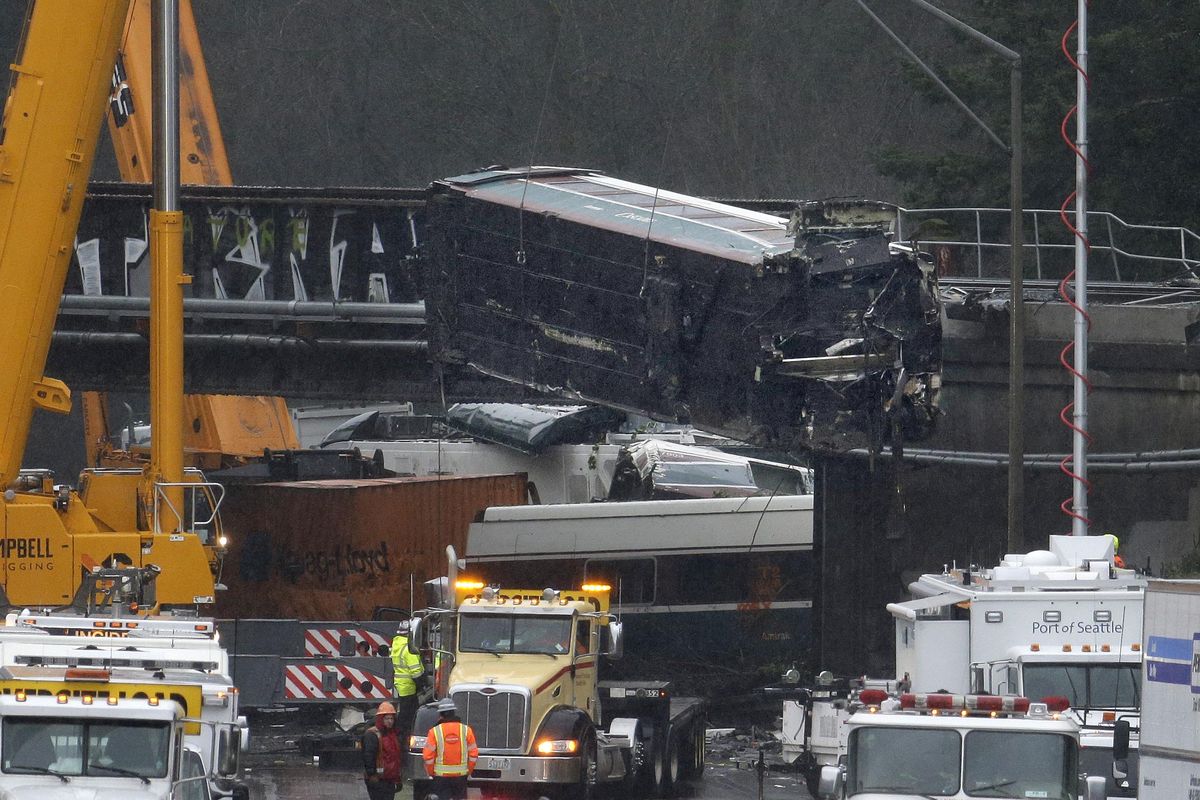Speeding Amtrak train didn’t brake before fatal crash near DuPont, according to NTSB analysis of data recorders

DUPONT, Wash. – The engineer of a train hurtling down a curving track at some 50 mph over the posted speed limit did not apply the brakes before the train began going off the tracks, investigators said Tuesday.
The Amtrak passenger train was traveling at 80 mph on track posted for 30 mph when it derailed Monday morning, said the head of the National Transportation Safety Board team searching for the cause of the fatal derailment on a bridge above Interstate 5.
The area where the train came off the tracks is on a curving, downward slope, and information from the train’s data recorders indicates the engineer did not apply brakes, NTSB investigator Bella Dinh-Zarr said at a news conference Tuesday afternoon. Instead, emergency brakes kicked in when the accident began.
NTSB investigators are looking at other factors besides speed that may have contributed to the accident, she said
State officials meanwhile, continued removing crumpled rail cars from the site of the accident, which killed three and injured more than 100.
Why was the train going so fast? “That’s a difficult one to answer,” Dinh-Zahr said. Investigators will be studying the time immediately before the accident to try determining that.
They couldn’t say yet whether the engineer was somehow distracted at the time of the accident. The engineer and a conductor who was “familiarizing himself with the territory” were in the cab of the locomotive, but both were injured and investigators haven’t had a chance to interview them yet.
Cameras that capture what’s occurring inside and outside the cab were heavily damaged in the crash and are being sent to a special laboratory in Washington, D.C., in an effort to get images from them.
They will also review the number of training runs the engineer had on the route, although he had been on the route enough in the previous two weeks to qualify under Amtrak guidelines.
Amtrak Cascade 501 was on its inaugural run before coming off the tracks and spilling some of its cars onto Interstate 5 between Tacoma and Olympia. It was getting positive train control technology installed, but that wasn’t functioning yet. That technology could have slowed the train automatically if the crew failed to do so. The controls, which were originally supposed to be in use nationwide by 2015, were later delayed by Congress until 2018 under pressure from the rail industry
“There are a thousand unanswered questions,” Gov. Jay Inslee said at a news conference near the derailment site. Whether the new technology would have made a difference isn’t known yet, he added.
Investigators have recovered the “black boxes” that tracked the train’s movements, and Inslee said he had faith the NTSB will find the cause.
“Whatever happened here will not be repeated,” he said.
The train was using a newly opened route for high-speed commuter services between Seattle and Portland, on a stretch that parallels I-5 between DuPont and Tacoma. One community along that route, Lakewood, fought the conversion of what had been a lightly used freight line to a more heavily used commuter line with higher speeds, but ultimately lost its lawsuit.
Lakewood’s main concerns, however, involved train traffic through its city limits, which have several roads that cross the tracks at grade. It had not raised questions about the rail bridge over I-5, which has a curve that is posted for travel at 30 mph. The bridge is outside the Lakewood city limits.
While the NTSB continued its investigation Tuesday, state Transportation Department officials began removing cars from the accident site. Five cars had been removed by cranes brought to the accident scene. Crumpled rail cars were lowered on flatbed trailers for transport to Joint Base Lewis McChord, where they will be placed in a secured area.
Other cars were moved throughout the day, with the biggest challenge being the derailed locomotive, which weighs more than 270,000 pounds and will require two tractor trailers, Washington State Patrol Capt. Dan Hall said.
“Each one of these cars has a unique challenge to them,” Hall said.
Southbound I-5 at DuPont was expected to remain closed at least through Tuesday night, and possibly for days.
Although reports Monday put the number of fatalities as high as six in the hours after the derailment, Hall reiterated Tuesday that there were only three fatalities, adding that all cars had been searched. He said reports of a higher number that continue to show up on social media and some news sites are wrong.
All of the fatalities were on the train, although some motorists on the highway below were hospitalized with injuries when the train came crashing down onto I-5.
Southbound lanes of Interstate 5 were closed south of Joint Base Lewis-McChord, and motorists were being warned to avoid the area. Clearing the scene was expected to take at least all of Tuesday, and possibly longer, Travis Phelps of the state Transportation Department said. After that, transportation staff must check the condition of the highway and the bridge to make sure they are safe before allowing traffic on that section of the interstate.
The state has recommended detours for those traveling from Seattle or Tacoma to Olympia, Portland or points south. But those routes use smaller state highways or city streets, and backups on some were as long as 16 miles. Phelps urged people who don’t have to make the trip to avoid it.
“It could be closed for several days,” Phelps said of the southbound lanes. Wind and rain could complicate the recovery operations, he added.
An estimated 60,000 motorists use the route on an average day, the Washington Department of Transportation said. There are few alternate routes, and the department was suggesting motorists going south from Tacoma go across the Puget Sound on the Tacoma Narrows Bridge and take state highways until they connect with U.S. 101 on the Olympic Peninsula.